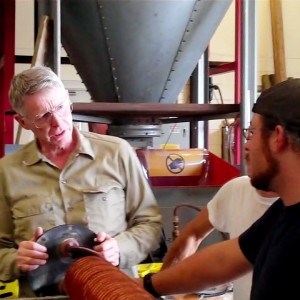3 Solar Hot Water Tanks Under Construction
This past week has been a particularly busy one out at the solar hot water systems shop. We’ve been working hard to get four Fluid Handling Systems ready to ship to our friends at Southern Energy Management. The first one to go out the door will be a 400 gallon solar hot water tank destined for a dormitory at Guilford Technical Community College. Check out the video below for a sneak peak.
The other three systems will be heading down to the Fayetteville VA Medical Center by the middle of August. Two of those solar hot water tanks will be the 500 gallon rectangular models also shown in the video below. The third FHS is a 1000 gallon cylindrical tank whose core components should be coming together sometime next week.
All four of these systems will be non-pressurized drain back designs. In choosing not to go with a pressurized glycol system, the owner is saving a boatload of cash by not having to use an ASME-rated tank. There are a lot of other benefits to gain when you ‘”Just say ‘No!'” to glycol. If you haven’t seen my 3-part video mini-series on pressurized solar hot water systems, click here.
Also, seats for the upcoming Solar Thermal Design Class are filling up so reserve your spot today. Remember, you can attend remotely but both physical and virtual seats are limited. Hope to see you there at the NC Solar Center on September 9th!
Dr. Ben
httpvh://www.youtube.com/watch?v=dYXvAT-nkgw&feature=channel_video_title


Dr. Ben,
Have you seen any of those “COLLAPSIBLE” solar hot water tanks out on the market? What are your thoughts on using these?
Chuck
Chuck,
Those tanks are basically an EPDM plastic pool liner with mechanical support structures to hold them up.
1. I don’t recommend plastic for any solar tank. It will not take high temps and pressure. Pool liners are rated ~ 180F max, but plastics operated close to their limit with water pressure applied can extrude at the seams and fail rapidly. They might work well with low efficiency systems that don’t get that hot, but they are not good solutions for serious professional systems. They are mainly for do-it-your-selfers. Have you ever seen a plastic water heater?
2. DIY assembly. Components may consist of a wood frame with insulation wrapped around the outside. Metal sheets are wrapped around the insulation and held on with big bands. The pool liner is installed inside the frame structure. These are definitely not a factory made, quality controlled product.
The “tank” sits on the floor, so keeping floor area dry is mandatory, or the wood will rot and the heat will be dumped in the floor. These tanks are meant for small systems up to ~ 300 gallons.
3. You cannot install a commercial heat exchanger in one. Boiler tube and finned coil type exchangers cannot be used with plastic tanks because they cannot be mounted horizontally through the tank face. One company talks about 3/4 in copper coils with capacities of 26,000 Btu/hr and 39,000 Btu/hr capacity. We regularly use 75,000 – 250,000 Btu/hr sizes.
4. Integration: Pumps, etc. must be site installed and piped and are generally not specified or supplied with the tank. They cannot be factory installed and wired because there is no tank structure to mount on until the pool is constructed.
I have nothing against DIY systems, but these plastic tanks are not for professional use, and I would never use plastic for any part of a solar system (excluding pool systems which don’t get hot).
I hope that helps!
Dr. Ben